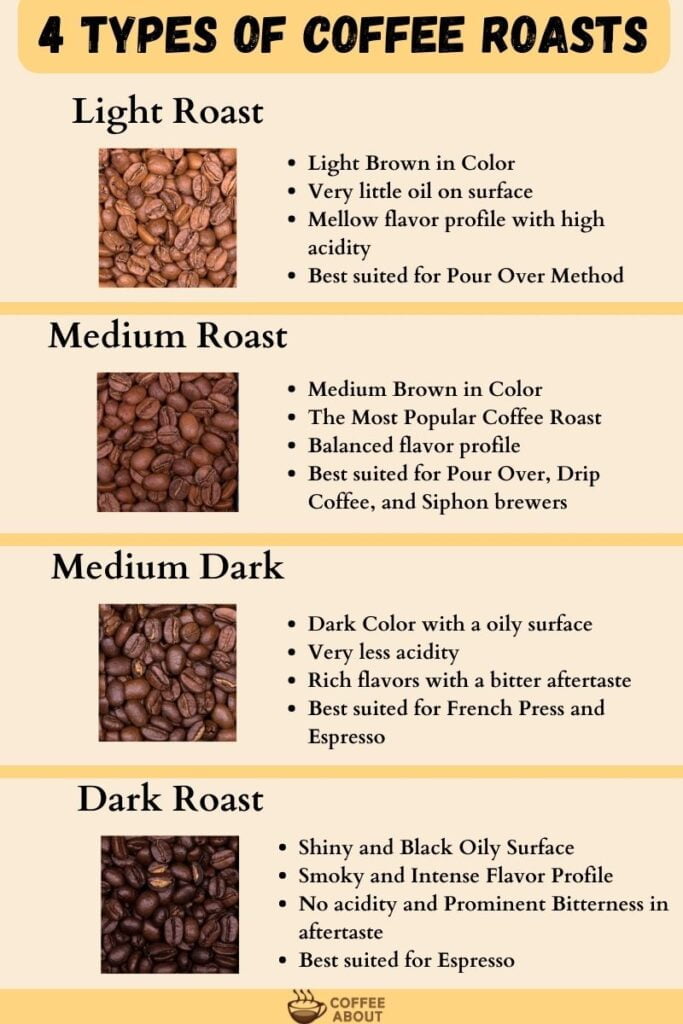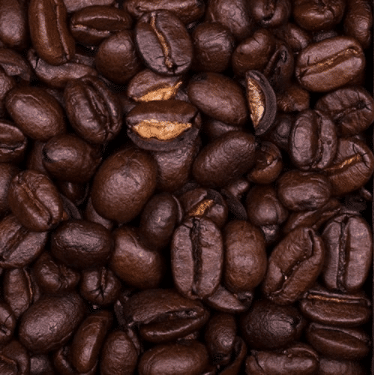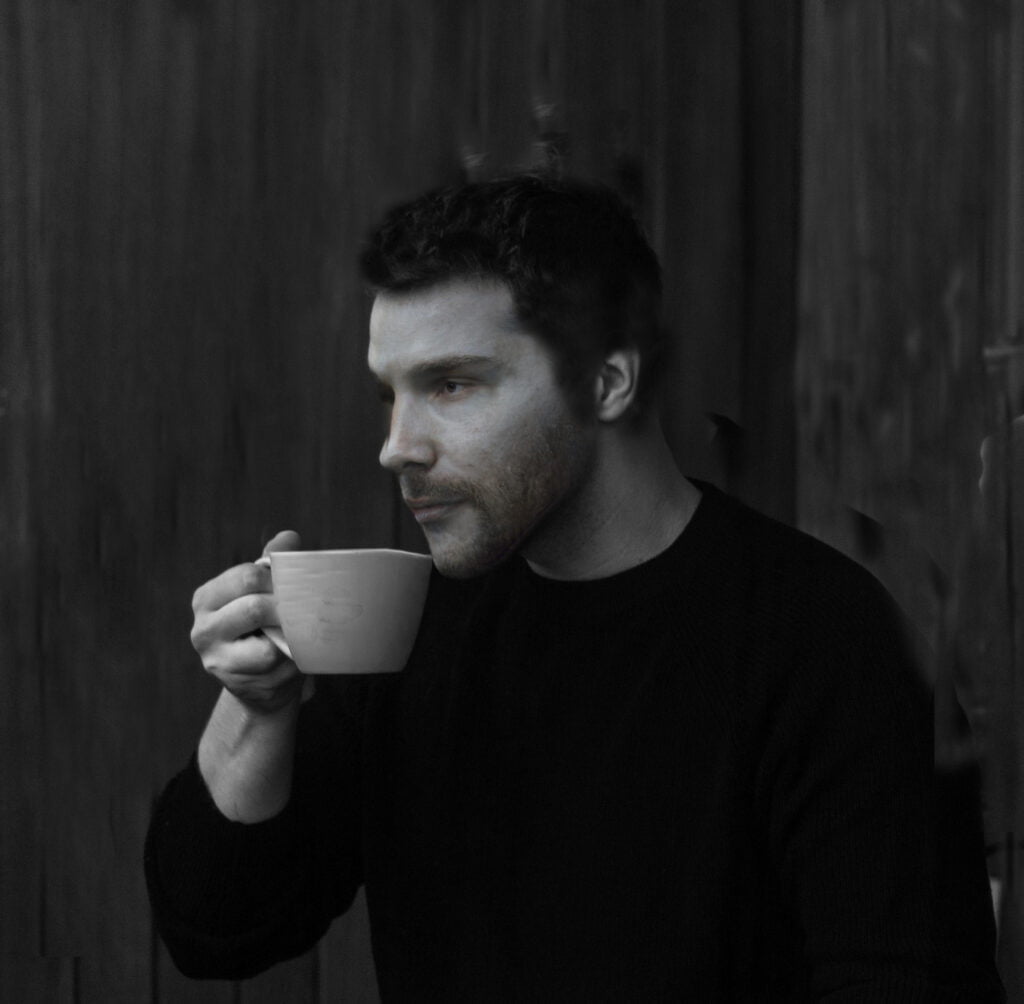There are four primary types of coffee roast i-e light, medium, medium-dark, and dark roast. Each brings out different flavors, acids, and aromas from the coffee beans.
Key Takeaways
- Roasting is the process that brings out the flavors and aroma of coffee beans
- Light Roasts are admired for the delicate and complex origin flavors of the beans
- Medium Roast has balanced flavors and is perfect for every brewing method
- Medium-dark roast has a Rich and full-bodied taste with low acidity
- Dark roast coffee has intense flavors and aromas that is perfect for espresso
Whether you want to improve your home brewing skills or upgrade your coffee shopping skills, it’s important to understand the different coffee roasts.
In this article, I will explain all the different types of coffee roasts, covering everything from their flavor profiles to their appearance, their different names, and ideal brewing methods for each roast.
4 Different Types of Coffee Roasts

Let’s get into a detailed explanation of all coffee roast levels!
1. Light roast Coffee beans
Light-roasted coffee beans are light brown in color and have a high acidity. They’re roasted for a shorter time at lower temperatures, usually around 355 to 400 degrees Fahrenheit for 3-5 minutes.
Light roasts have the highest caffeine content compared to darker roasts but the difference is very minimal.
Light roast coffee beans really bring out the essence of where they come from, giving you a one-of-a-kind sensory experience. These beans retain earthy and fruity flavors reminiscent of raw green coffee, preserving the distinctive characteristics of their origin.

Always get the lighter roasts when buying specialty single-origin coffee beans. Light roasting lets you taste the unique flavors of that origin. Darker roasts can overpower those regional flavor notes.
Some Common Names for Light Roast
Light roasted beans are often packaged and marketed under the following names.
- Light City
- Half City
- Blonde Roast
- Cinnamon Roast
- New England
What Brewing Method is perfect for Light roast coffee beans
Light roast beans have delicate floral, fruity, and earthy notes that are best brought out through pour-over brewing. This manual method gives you the chance to experiment and dial in variables like water temperature and flow rate. Finding the right balance is key to coaxing subtle flavors from light roasts.
Light roasts are best for enjoying simple black coffee without any milk or sweeteners as they make a sweet, tea-like notes, and less bitter drink.
Avoid methods like the French press which do not filter out coffee oils and sediments. These methods can make light roasts taste muddled.
Features of light roast
| Taste profile | Delicate, Vibrant, and fruity notes |
| Color | Light brown |
| Body | Light and crisp body |
| Aroma | Pronounced floral and fruity scents |
| Best Brewing Methods | Pour-over, Chemex, Hario V60; methods that allow for precise control. |
Read a Guide on White Coffee – The Extra Light Roasted coffee
2. Medium roast Coffee beans
Medium roast beans have a brown color and deliver moderately intense flavor with smooth acidity. They sit in the sweet spot between light and dark roasts.
Medium Roasts are roasted at temperatures between 400-430°F (204-221°C), going beyond the first crack but not reaching the second crack. This level of roasting creates a well-rounded flavor profile, balancing the coffee’s inherent characteristics with flavors developed during the roasting process.
Medium roast is the most popular coffee roast, as it offers an approachable yet complex taste experience. The acidity is moderate, providing a pleasant brightness without overwhelming the palate.

Medium roasts hit that sweet spot for folks who find light roasts a bit too bright and acidic but think dark roasts taste a little burnt or ashy. The smooth, well-rounded profile of a medium roast can be an easy-drinking everyday brew.
Some Common Names for Medium Roast
Medium roasted beans are often packaged and marketed under the following names.
- American Roast
- City
- Regular Roast
- Breakfast Roast
- Balanced Roast
What Brewing Method is perfect for Medium roast coffee beans
Medium roast coffee beans are highly versatile as they have moderate levels of acidity, sweetness, and body. This allows them to brew well under a wide range of conditions and with any brew methods.
In general, Medium roasted beans are the perfect choice for Drip coffee machines, Siphon brewers, and Aeropress coffee maker
Features of Medium roast
| Taste profile | Balanced and versatile |
| Color | Medium brown in color |
| Body | Medium body without being too heavy or too light. |
| Aroma | Includes both the bean’s inherent scents and subtle roasting aromas |
| Best Brewing Methods | Suitable for any brewing method |
3. Medium-Dark roast coffee beans
Medium-dark roast coffee is roasted to a temperature range of 220°C to 230°C (430°F to 450°F), reaching the beginning or middle of the second crack. At this point, the beans have a darker brown color and a light coating of oil on the surface.
This roast is known for its full-bodied profile, very less acidity, and prominent notes of caramel and chocolate. The extended roasting process introduces a slight spiciness and a hint of smokiness, accompanied by a bittersweet tang.

Some Common Names for Medium Dark Roast
Medium Dark roasted beans are often packaged and marketed under the following names.
- Full City
- Viennese Roast
- After dinner Roast
- Continental Roast
- Classic Roast
What Brewing Method is perfect for Medium Dark roast coffee beans
Medium-dark roast coffee beans pair nicely with brewing methods that can extract the deeper, richer flavors in the beans.
The full immersion of a French press draws out the heavy body and robust roasty flavors of medium-dark beans, while the high pressure used in espresso concentrates the coffee’s oils and solids into a potent, syrupy shot that complements these bolder roasts.
Other strong coffee brewing methods like Moka Pot, Cold Brew, and Aeropress also work well with Medium Dark roast.
Features of Medium Dark roast
| Taste profile | Bold flavors with a bittersweet aftertaste |
| Color | Dark Brown |
| Body | Full-bodied flavor, providing a satisfying mouthfeel |
| Aroma | Rich, toasty, and smoky scents |
| Best Brewing Methods | French press, Espresso, cold brew, and Moka Pot |
4. Dark-roasted coffee beans
Dark roasts are roasted to a point where the beans become very dark brown or black in color and develop a thin layer of oil on their surface.
These beans roasted at a temperature between 220°C and 230°C (430°F to 450°F), reaching and often surpassing the second crack in the roasting process.
The flavor profile of dark roast coffee is bold and robust, often described as smoky or bittersweet. It typically has a full body and low acidity, with prominent notes of dark chocolate, caramel, and sometimes a hint of nuttiness. The intense roasting process largely overshadows the original characteristics of the coffee’s origin, creating a more uniform flavor across different bean varieties.
The roasting process for dark roast coffee requires careful attention to avoid over-roasting or burning the beans. Skilled roasters aim to develop the deep, complex flavors associated with dark roasts without introducing unpleasant burnt, or overly bitter notes.
Dark roast coffee is most popular in European coffee cultures due to its bold flavor profile. The deep, often bitter, and ashy tones of dark roasted beans suit the strong brewing methods common in Europe, like the French Press, Moka Pot, and Espresso.

Some Common Names for Dark Roast
Dark roasted beans are often packaged and marketed under the following names.
- French Roast
- Italian Roast
- Espresso Roast
- New Orleans
- European Roast
What Brewing Method is perfect for Dark roast coffee beans
Dark roast coffee beans are known for their bold and intense flavors, often with smoky and roasted notes.
That’s why Dark roasted is considered best for Espresso as the quick, high-pressure extraction concentrates the sweeter crema while mitigating bitter overtones in dark roast espresso shots.
Dark roastes are the also most preferable beans for milk-based coffee drinks. Milk nicely complements the bitterness and full-bodied taste of dark roasts and tames the harshness.
Features of Dark roast
| Taste profile | Intense and bold with prominent bitterness; dominated by roast-derived flavors |
| Color | Nearly Black in Color |
| Body | Full and heavy body with creamy mouthfeel |
| Aroma | Intensely smoky and toasty, with hints of dark chocolate and spices |
| Best Brewing Methods | Espresso, French Press |
What is coffee roasting?
Coffee roasting is a complex process that involves heating green coffee beans to a specific temperature for a specific period of time. This process causes chemical changes in the beans that bring out the unique flavor and aroma of coffee.
Typically, roasting is done at a very high temperature between 300 and 450 degrees Fahrenheit. The roaster has to keep a close eye (and ear) on the process, monitoring heat levels and listening for cues like the “second crack”.
The longer the roast goes on past that second crack, the darker the roast will be. Light roasts are pulled out just after the first crack, while dark roasts can push past that second crack into the land of intense and smoky notes.
Coffee beans can be roasted at home using a variety of methods, including a frying pan, an air popper, or a popcorn maker.
The best way to roast coffee beans is with a professional roaster, which can control the temperature and airflow more precisely.

Green Coffee beans
Coffee beans are grown on trees in the form of red cherry, and you cannot simply use them as it is to brew your cup of coffee, for sure!
Green coffee beans are found inside red cherries. The beans are removed from the cherries, washed with water, and dried in the sun. Once the beans are dry, they are roasted to bring them into the familiar shape we see them in.
These are the raw beans that are just taken out of the cherries and are not suitable for brewing a cup of coffee.
However, some coffee enthusiasts buy raw green coffee and roast these beans by themselves in home roasting machines.

Read Related Guides:
FAQs
Which roast of coffee is best?
The “best” roast of coffee is highly subjective and depends on personal taste preferences. However, the Medium roast is the most popular coffee roast because of its rich and delicate flavor profiles.
I suggest you try every coffee roast and select the one that suits you the best.
What Coffee Roast is the Strongest
Dark roast makes the strongest and boldest coffee drinks. The extended roasting process produces intense flavors along with a very dense body.
Which coffee roast is bitter?
Dark roast coffee is generally more bitter compared to lighter roast levels.
Dark roasts are pushed past the second crack to very high temperatures, which can impart a burnt, charred taste while also enhancing the sweetness.
However, dark roasts are not universally bitter. Roasters can reduce bitterness by sourcing less acidic beans, controlling temperature, and stopping before burning.
Which coffee roast is sweeter?
Medium roast coffee beans have sweeter and more balanced flavor profiles.
The shorter roasting times in medium styles preserve more of the bean’s inherent sugars and fruity acids, both of which we perceive as sweetness.
Which coffee roast is healthier?
Light and medium roasts are considered healthier than dark roasts; however, the overall nutritional differences between roast styles are quite small.
The shorter roasting times for light and medium roasts better preserve many of coffee’s beneficial antioxidants, polyphenols, vitamins, and caffeine content.
Which Coffee Roast has The Most Caffeine?
Light roast coffee has more caffeine by volume, while dark roast has more caffeine by weight because the beans lose mass during roasting. However, the actual caffeine content in a single identical light or dark roast bean remains the same. Roasting does not significantly affect caffeine levels; instead, the bean’s variety and origin are the key factors that determine caffeine content.




Cool breakdown! I’m all about that dark roast life. Anyone else think light roasts taste kinda sour? Or am I just brewing it wrong?
Hey there, coffee fiend!
Totally get your dark roast love. Light roasts can be tricky.
Yeah, they can taste a bit sour. But not always in a bad way, they do have some delightful fruity flavors.
Here’s a tip: Try using more water for light roasts. And give ’em a bit more brewing time.
This can mellow out that sourness.
Thanks for explaining coffee roast types! Always wondered why some coffee tastes fruity and others taste bitter. Will look out for the type of roast while buying coffee next time!